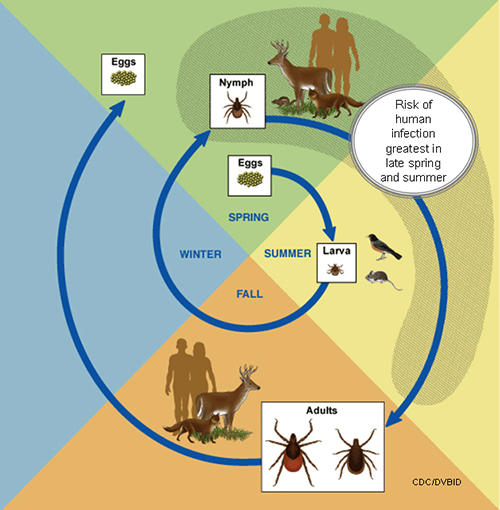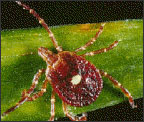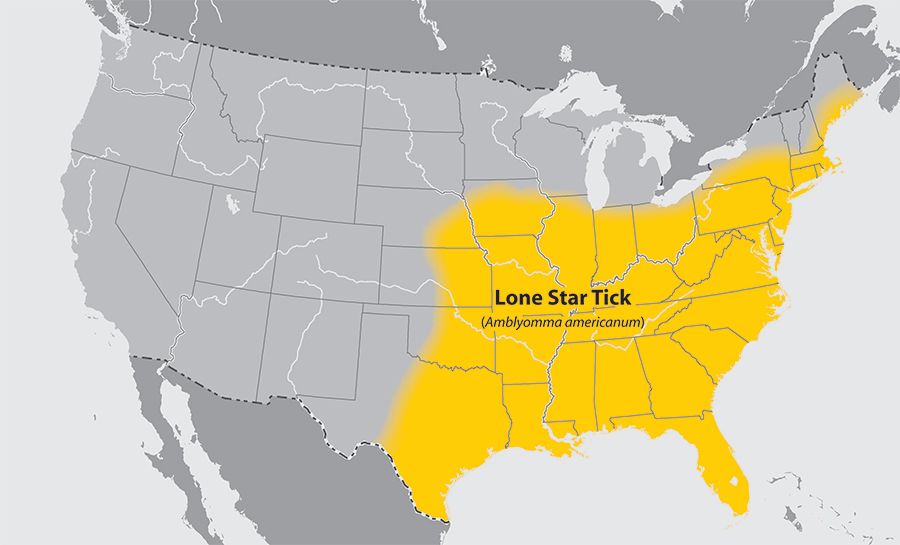Amblyomma americanum: Difference between revisions
Jump to navigation
Jump to search
No edit summary |
No edit summary |
||
| Line 47: | Line 47: | ||
*A feeding tube enters the host followed by an adhesive-like substance, attaching the tick to the host during the blood meal. | *A feeding tube enters the host followed by an adhesive-like substance, attaching the tick to the host during the blood meal. | ||
*A tick will feed for several days, feeding on the host blood and ingesting the host's pathogens. | *A tick will feed for several days, feeding on the host blood and ingesting the host's pathogens. | ||
*Once feeding is completed, the tick will seek a new host and transfer any pathogens during the next feeding process. <ref name="LCT CDC”">Life Cycle of Ticks that Bite Humans (2015). http://www.cdc.gov/ticks/life_cycle_and_hosts.html Accessed on December 30, 2015</ref> | *Once feeding is completed, the tick will seek a new host and transfer any pathogens during the next feeding process. <ref name="LCT CDC”">Life Cycle of Ticks that Bite Humans (2015). http://www.cdc.gov/ticks/life_cycle_and_hosts.html Accessed on December 30, 2015</ref>{{Clear}} | ||
==''Amblyomma americanum'' Transmitted Diseases== | |||
* Human monocytotropic ehrlichiosis (''[[Ehrlichia chaffeensis]]'') | |||
* Canine and Human granulocytic ehrlichiosis (''[[Ehrlichia ewingii]]'') | |||
* Tularemia (''[[Francisella tularensis]]'') | |||
* [[southern tick-associated rash illness]] (STARI, possibly caused by the spirochete ''[[Borrelia lonestari]]'').<ref>{{cite journal |author=Edwin J. Masters, Chelsea N. Grigery & Reid W. Masters |title=STARI, or Masters disease: lone star tick-vectored Lyme-like illness |journal=[[Infectious Disease Clinics of North America]] |volume=22 |issue=2 |pages=361–376, viii |date=June 2008 |pmid=18452807 |doi=10.1016/j.idc.2007.12.010}}</ref> STARI exhibits a rash similar to that caused by [[Lyme disease]], but is generally considered to be less severe. | |||
* Though the primary bacterium responsible for Lyme disease, ''[[Borrelia burgdorferi]]'', has occasionally been isolated from lone star ticks, numerous vector competency tests have demonstrated that this tick is extremely unlikely to be capable of transmitting Lyme disease. | |||
* Some evidence indicates ''A. americanum'' saliva inactivates ''B. burgdorferi'' more quickly than the saliva of ''[[Ixodes scapularis]]''.<ref name="pmid15752182">{{cite journal |author=K. E. Ledin, N. S. Zeidner, J. M. C. Ribeiro, B. J. Biggerstaff, M. C. Dolan, G. Dietrich, L. VredEvoe & J. Piesman |title=Borreliacidal activity of saliva of the tick ''Amblyomma americanum'' |journal=[[Medical and Veterinary Entomology]] |volume=19 |issue=1 |pages=90–95 |date=March 2005 |pmid=15752182 |doi=10.1111/j.0269-283X.2005.00546.x |url=http://www.blackwell-synergy.com/openurl?genre=article&sid=nlm:pubmed&issn=0269-283X&date=2005&volume=19&issue=1&spage=90}}</ref> | |||
{{ | * Recently the bacteria ''[[Borrelia andersonii]]'' and ''[[Borrelia americana]]'' have been linked to ''Amblyomma americanum''.<ref>{{Cite doi|10.7150/ijms.6273}}</ref> | ||
* In response to two cases of severe febrile illness occurring in two farmers in northwestern Missouri, researchers determined the lone star tick can transmit the [[heartland virus]] in 2013.<ref>{{Cite doi|10.4269/ajtmh.13-0209}}</ref> | |||
* Six more cases were identified in 2012–2013 in Missouri and Tennessee.<ref>http://www.cdc.gov/media/releases/2014/p0327-heartland.html</ref> | |||
{{ | |||
== | ==Meat allergy== | ||
<!-- According to research by Drs [[Thomas Platts-Mills]] and Scott Commins published in 2011 -->* The bite of this tick can cause a person to develop a [[meat allergy]] to nonprimate mammalian meat and meat products.<ref>{{cite journal |last=Commins |first=Scott P. |last2=James |first2=Hayley R. |last3=Kelly |first3=Libby A. |last4=Pochan |first4=Shawna L. |last5=Workman |first5=Lisa J. |last6=Perzanowski |first6=Matthew S. |last7=Kocan |first7=Katherine M. |last8=Fahy |first8=John V. |last9=Nganga |first9=Lucy W. |last10=Ronmark |first10=Eva |last11=Cooper |first11=Philip J. |last12=Platts-Mills |first12=Thomas A.E. |date=May 2011 |title=The relevance of tick bites to the production of IgE antibodies to the mammalian oligosaccharide galactose-α-1,3-galactose |url=http://www.jacionline.org/article/S0091-6749%2811%2900344-7/abstract |journal=The Journal of Allergy and Clinical Immunology |volume=127 |issue=5 |pages=1286-1293 |doi=10.1016/j.jaci.2011.02.019 |accessdate=20 May 2014 |pmid=21453959 |pmc=3085643}}</ref> | |||
* This allergy is characterized by adult onset, and a delayed reaction of [[urticaria]] or [[anaphylaxis]] appearing 4–8 hours after consumption of the allergen. | |||
* The allergen has been identified as a carbohydrate called [[galactose-α-1,3-galactose]] (alpha gal). | |||
* As well as occurring in nonprimate mammals, alpha gal is also found in cat dander and a drug used to treat head and neck cancer. | |||
* Commercial tests for alpha gal IgE became available following research. | |||
Geographic Distribution | |||
It is very widespread in the United States ranging from Texas to Iowa in the Midwest and east to the coast where it can be found as far north as Maine.<ref>{{cite journal |author=James E. Childs & Christopher D. Paddock |title=The ascendancy of ''Amblyomma americanum'' as a vector of pathogens affecting humans in the United States |journal=[[Annual Review of Entomology]] |volume=48 |issue=1 |pages=307–337 |year=2003 |pmid=12414740 |doi=10.1146/annurev.ento.48.091801.112728}}</ref> It is most common in wooded areas, particularly in forests with thick underbrush, and large trees. | |||
{{Clear left}} | |||
==Bibliography== | ==Bibliography== | ||
| Line 86: | Line 91: | ||
* Disease transmitted: [[ehrlichiosis]], [[tularemia]], [[southern tick-associated rash illness]] | * Disease transmitted: [[ehrlichiosis]], [[tularemia]], [[southern tick-associated rash illness]] | ||
<gallery widths=350px> | <gallery widths="350px"> | ||
Amblyomma americanum.jpg | Lone star tick (''Amblyomma americanum'') <br> [http://www.cdc.gov/ticks/geographic_distribution.html <font size="-2">''Adapted from CDC''</font>] | Amblyomma americanum.jpg | Lone star tick (''Amblyomma americanum'') <br> [http://www.cdc.gov/ticks/geographic_distribution.html <font size="-2">''Adapted from CDC''</font>] | ||
Revision as of 17:43, 17 February 2016
| style="background:#Template:Taxobox colour;"|Lone star tick | ||||||||||||||||
|---|---|---|---|---|---|---|---|---|---|---|---|---|---|---|---|---|
| style="background:#Template:Taxobox colour;" | Scientific classification | ||||||||||||||||
| ||||||||||||||||
| Binomial name | ||||||||||||||||
| Amblyomma americanum (Linnaeus, 1758) [1] | ||||||||||||||||
| Red indicates where the species is normally found; Blue indicates other locations where the species has been reported Red indicates where the species is normally found; Blue indicates other locations where the species has been reported
|
Editor-In-Chief: C. Michael Gibson, M.S., M.D. [1]
Overview
Amblyomma americanum, or lone star tick, is a species of tick in the genus Amblyomma.
Life Cycle
General Tick Life Cycle

- A tick's life cycle is composed of four stages: hatching (egg), nymph (six legged), nymph (eight legged), and an adult.
- Ticks require blood meal to survive through their life cycle.
- Hosts for tick blood meals include mammals, birds, reptiles, and amphibians. Ticks will most likely transfer between different hosts during the different stages of their life cycle.
- Humans are most often targeted during the nymph and adult stages of the life cycle.
- Life cycle is also dependent on seasonal variation.
- Ticks will go from eggs to larva during the summer months, infecting bird or rodent host during the larval stage.
- Larva will infect the host from the summer until the following spring, at which point they will progress into the nymph stage.
- During the nymph stage, a tick will most likely seek a mammal host (including humans).
- A nymph will remain with the selected host until the following fall at which point it will progress into an adult.
- As an adult, a tick will feed on a mammalian host. However unlike previous stages, ticks will prefer larger mammals over rodents.
- The average tick life cycle requires three years for completion.
- Different species will undergo certain variations within their individual life cycles. [2]
Spread of Tick-borne Disease
- Ticks require blood meals in order to progress through their life cycles.
- The average tick requires 10 minutes to 2 hours when preparing a blood meal.
- Once feeding, releases anesthetic properties into its host, via its saliva.
- A feeding tube enters the host followed by an adhesive-like substance, attaching the tick to the host during the blood meal.
- A tick will feed for several days, feeding on the host blood and ingesting the host's pathogens.
- Once feeding is completed, the tick will seek a new host and transfer any pathogens during the next feeding process. [2]
Amblyomma americanum Transmitted Diseases
- Human monocytotropic ehrlichiosis (Ehrlichia chaffeensis)
- Canine and Human granulocytic ehrlichiosis (Ehrlichia ewingii)
- Tularemia (Francisella tularensis)
- southern tick-associated rash illness (STARI, possibly caused by the spirochete Borrelia lonestari).[3] STARI exhibits a rash similar to that caused by Lyme disease, but is generally considered to be less severe.
- Though the primary bacterium responsible for Lyme disease, Borrelia burgdorferi, has occasionally been isolated from lone star ticks, numerous vector competency tests have demonstrated that this tick is extremely unlikely to be capable of transmitting Lyme disease.
- Some evidence indicates A. americanum saliva inactivates B. burgdorferi more quickly than the saliva of Ixodes scapularis.[4]
- Recently the bacteria Borrelia andersonii and Borrelia americana have been linked to Amblyomma americanum.[5]
- In response to two cases of severe febrile illness occurring in two farmers in northwestern Missouri, researchers determined the lone star tick can transmit the heartland virus in 2013.[6]
- Six more cases were identified in 2012–2013 in Missouri and Tennessee.[7]
Meat allergy
- The bite of this tick can cause a person to develop a meat allergy to nonprimate mammalian meat and meat products.[8]
- This allergy is characterized by adult onset, and a delayed reaction of urticaria or anaphylaxis appearing 4–8 hours after consumption of the allergen.
- The allergen has been identified as a carbohydrate called galactose-α-1,3-galactose (alpha gal).
- As well as occurring in nonprimate mammals, alpha gal is also found in cat dander and a drug used to treat head and neck cancer.
- Commercial tests for alpha gal IgE became available following research.
Geographic Distribution
It is very widespread in the United States ranging from Texas to Iowa in the Midwest and east to the coast where it can be found as far north as Maine.[9] It is most common in wooded areas, particularly in forests with thick underbrush, and large trees.
Bibliography
- Piesman J, Sinsky RJ., Ability of Ixodes scapularis, Dermacentor variabilis, and Amblyomma americanum (Acari: Ixodidae) to acquire, maintain, and transmit Lyme disease spirochetes (Borrelia burgdorferi) ; J Med Entomol. 1988 September; 25(5):336-9.
References
- ↑ Template:EOL
- ↑ 2.0 2.1 Life Cycle of Ticks that Bite Humans (2015). http://www.cdc.gov/ticks/life_cycle_and_hosts.html Accessed on December 30, 2015
- ↑ Edwin J. Masters, Chelsea N. Grigery & Reid W. Masters (June 2008). "STARI, or Masters disease: lone star tick-vectored Lyme-like illness". Infectious Disease Clinics of North America. 22 (2): 361–376, viii. doi:10.1016/j.idc.2007.12.010. PMID 18452807.
- ↑ K. E. Ledin, N. S. Zeidner, J. M. C. Ribeiro, B. J. Biggerstaff, M. C. Dolan, G. Dietrich, L. VredEvoe & J. Piesman (March 2005). "Borreliacidal activity of saliva of the tick Amblyomma americanum". Medical and Veterinary Entomology. 19 (1): 90–95. doi:10.1111/j.0269-283X.2005.00546.x. PMID 15752182.
- ↑ Template:Cite doi
- ↑ Template:Cite doi
- ↑ http://www.cdc.gov/media/releases/2014/p0327-heartland.html
- ↑ Commins, Scott P.; James, Hayley R.; Kelly, Libby A.; Pochan, Shawna L.; Workman, Lisa J.; Perzanowski, Matthew S.; Kocan, Katherine M.; Fahy, John V.; Nganga, Lucy W.; Ronmark, Eva; Cooper, Philip J.; Platts-Mills, Thomas A.E. (May 2011). "The relevance of tick bites to the production of IgE antibodies to the mammalian oligosaccharide galactose-α-1,3-galactose". The Journal of Allergy and Clinical Immunology. 127 (5): 1286–1293. doi:10.1016/j.jaci.2011.02.019. PMC 3085643. PMID 21453959. Retrieved 20 May 2014.
- ↑ James E. Childs & Christopher D. Paddock (2003). "The ascendancy of Amblyomma americanum as a vector of pathogens affecting humans in the United States". Annual Review of Entomology. 48 (1): 307–337. doi:10.1146/annurev.ento.48.091801.112728. PMID 12414740.
External links
Gallery
- Common name: lone star tick
- Scientific name: Amblyomma americanum
- Reservoir: birds and deer (larvae and nymphs); white-tailed deer (adult ticks)
- Geographic distribution: southeastern and eastern United States
- Disease transmitted: ehrlichiosis, tularemia, southern tick-associated rash illness
-
Lone star tick (Amblyomma americanum)
Adapted from CDC -
Approximate distribution of the lone star tick
Adapted from CDC

